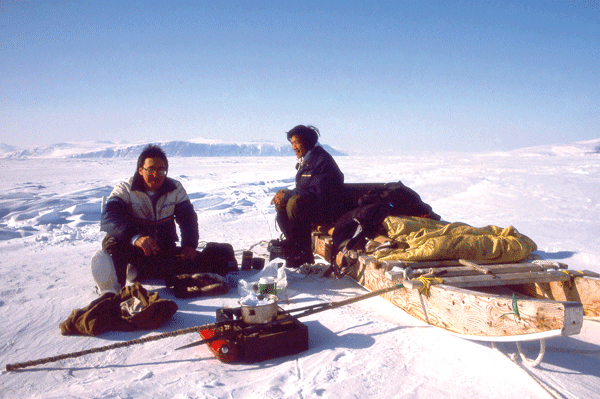Climate Change
The Arctic and Subarctic are two of the first areas in the world to experience the direct and local level impacts of a warming planet, and we Inuit recognize that our homelands play a central role in regulating the Earth’s climate system. Our relationship with our environment has already been profoundly altered.
Inuit have been documenting and raising awareness about the local level impacts of climate change for more than a decade. Through Inuit-led research and advocacy, we have succeeded in drawing the world’s attention to many of the climate-related changes our people are observing and experiencing in Inuit Nunangat. We have shown how climate change is yet another stress factor that Inuit communities are grappling with in a context of widespread social inequity, emphasizing the human dimensions of this challenge.
While working to address the socio-economic inequities we face, we have also worked for many years to document and share our knowledge of changing northern conditions, including our observations of the complexity of changing sea ice conditions; altered bird, mammal and fish migration patterns; alterations to our traditional travel routes; and shifting access to our country foods. Our country food consumption patterns, preparation and storage methods are changing.
We were among the first to put a human face on the unprecedented climate changes happening in the North. The environment of risk that Inuit are born into is intensifing because of climate change. Changing ice patterns and unpredictable weather have caused experienced harvesters to change their hunting strategies in response to increased risks, especially since existing rescue facilities are inadequate. We are deeply concerned about these impacts on our youth — their ability to safely engage in harvesting activities and to learn from our Elders about our way of life is increasingly compromised.
Most of our Elders were born on the Land, and they have seen the creation of permanent settlements in their lifetimes — settlements currently dependent on highly carbon-intensive supply chains, energy and heat sources. Their values and their knowledge were shaped and based on a relationship with an environment that was stable, and a way of life that embraced the sea ice and the cold. For us, sea ice is a fundamental source of food, learning, memories, knowledge and wisdom.

Our use and occupation of Arctic and Subarctic lands, ice and waters predates European contact, stretching back thousands of years. We have spent generations documenting our use and reliance on Arctic lands, ice and waters through a variety of land use and occupancy studies.
Unprecedented rates of summer sea ice loss, reduced sea ice in the winter, ocean acidification, temperature and sea level rise, melting permafrost, extreme weather events and severe coastal erosion undermine our ability to thrive in our environment. Rapid climate change is affecting our ability to access our country foods (wild foods harvested from our lands and waters) at a time when too many families are already struggling to put food on the table. There is an increase in hazards and risks on ice, including increased incidents of Inuit falling through ice, some of which can be attributed to the warming environment and unpredictable weather. There have been studies showing that Inuit who are cut off from traditional seasonal activities like hunting and fishing suffer impacts to their mental health and sense of identity.
In recent years, Inuit Nunangat has experienced significant changes in sea ice extent and characteristics. Average sea ice thickness is decreasing, and the sea ice cover is now dominated by younger, thinner ice. Ice breakup now occurs earlier and freeze-up is delayed, resulting in a longer melt season.
Our use and occupation of Arctic and Subarctic lands, ice and waters predates European contact stretching back thousands of years.
Changes in the natural environment (e.g., sea, lake and river ice loss, melting permafrost, shifts in water quality and availability, coastal erosion, etc.) have significant impacts on existing infrastructure, including threats to the stability of our homes and public infrastructure such as roads and runways. All of this is having a major impact on Inuit culture, sovereignty, mental wellness and livelihoods.
Inuit take a holistic approach to understanding the social determinants of our health and the factors — including climate change — that affect those determinants. Social determinants of health include the conditions in which people are born, grow, work, live and age, as well as the wider set of forces and systems (i.e., economic policies, social policies and political systems) shaping the conditions of daily life.
Climate change multiplies the disparities Inuit face, and we must help lead the way in designing climate solutions that are tailored for the diverse regional needs that exist in our homelands. We must ensure that climate actions lessen the social and economic disparities we face, and lead to the development of sustainable, thriving and climate-resilient communities.
When Canadians next consider the North as a symbol of the challenge Canada and the world face to adapt to a “new climate normal,” it is imperative that Inuit visions for our homelands are top of mind when considering the opportunities and challenges posed by newly accessible resources or shipping corridors in the Arctic and Subarctic. For Inuit, it is fundamentally important that Canadians recognize the key role of our people, and our vision for adapting and thriving in the “new North.” We are determined that our voice on the future of our homelands be heard.


Order now
from Amazon.ca or Chapters.Indigo.ca or contact your favourite bookseller or educational wholesaler




